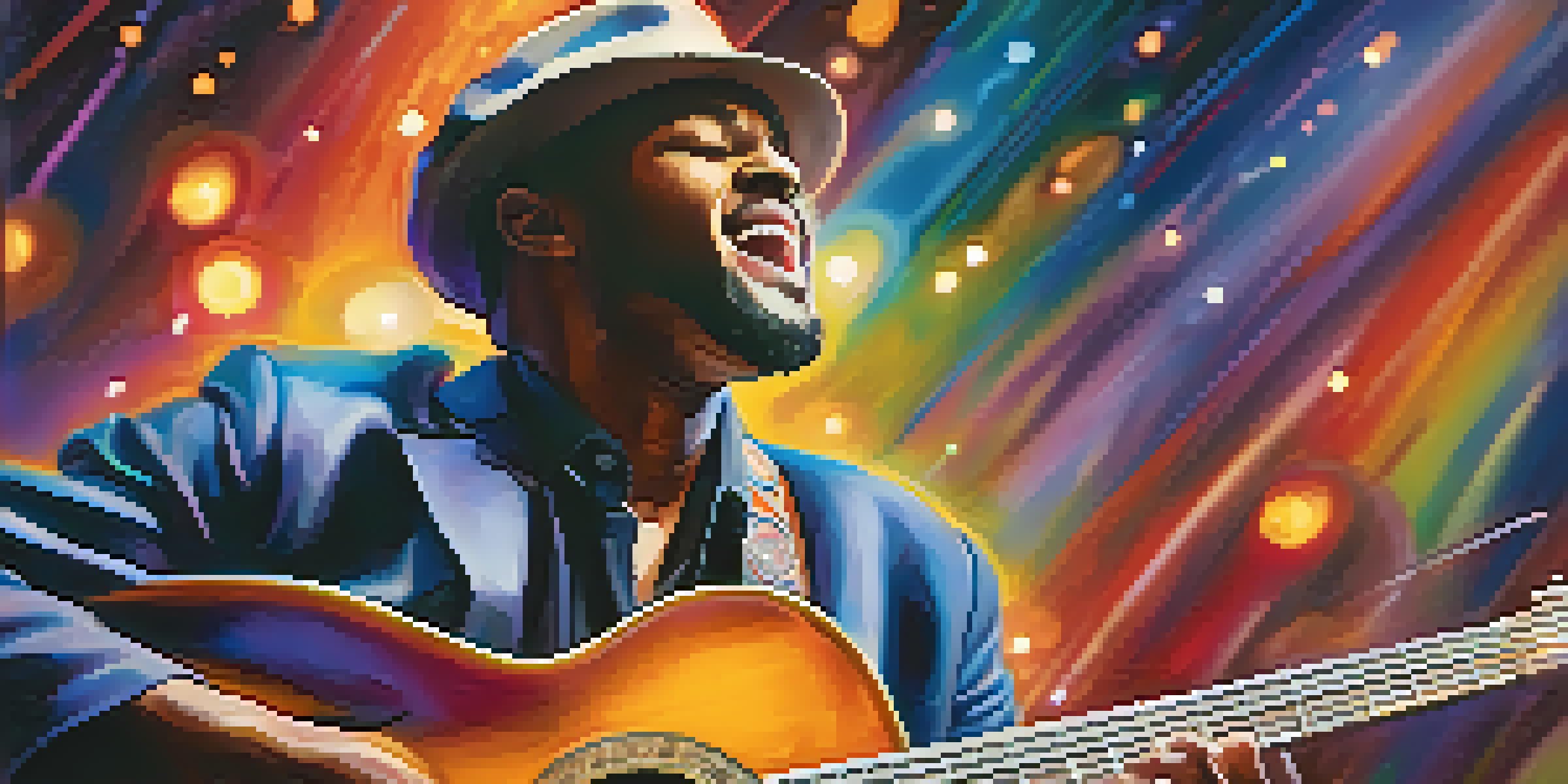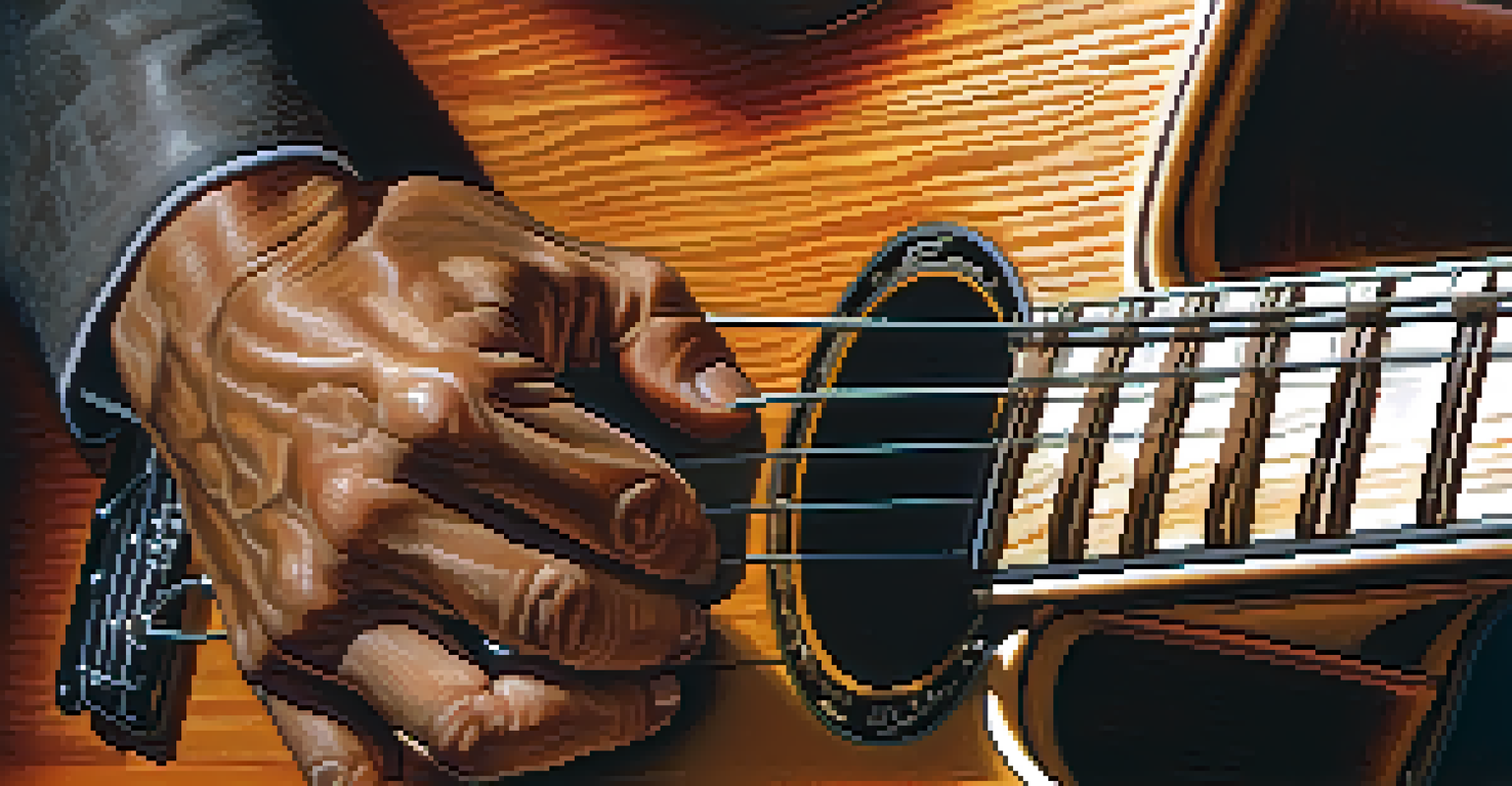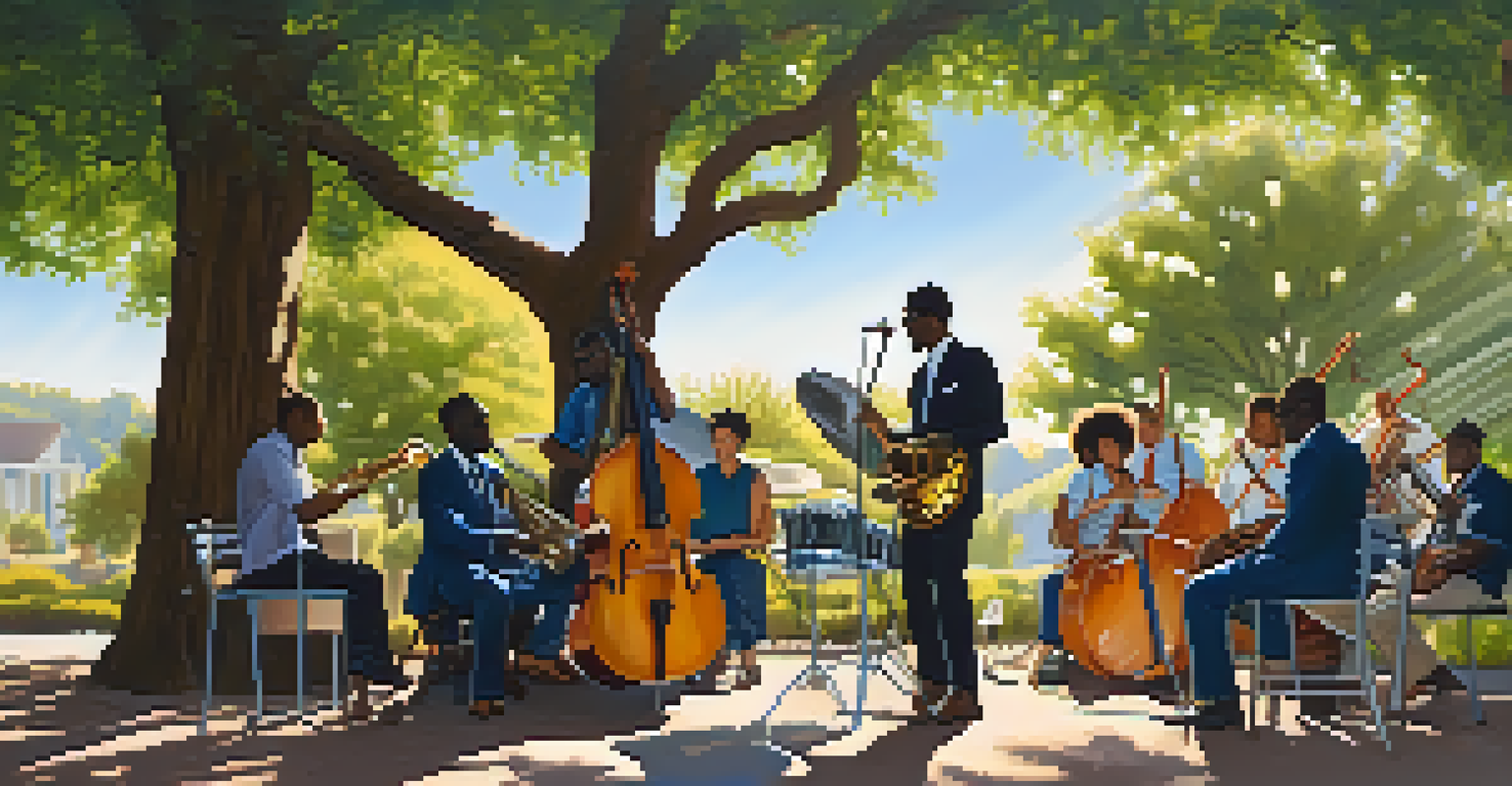Understanding Jazz Guitar: Techniques and Unique Styles

The Roots of Jazz Guitar: A Historical Perspective
Jazz guitar has deep roots that trace back to the early 20th century, evolving from blues and ragtime. It began to gain recognition when musicians sought a way to express their creativity through chord progressions and improvisation. Notable figures like Django Reinhardt and Charlie Christian played pivotal roles in shaping this genre, blending various elements to create a unique sound.
Jazz is the only music in which the same note can be played night after night but differently each time.
In the 1940s and 1950s, jazz guitar further blossomed with the rise of bebop, where players began to explore complex chords and fast tempos. This era saw the emergence of influential guitarists like Wes Montgomery, who brought a new dimension to jazz with his thumb-picking technique. Each of these artists contributed to the rich tapestry of jazz guitar, making it a vital part of the jazz landscape.
Today, jazz guitar continues to evolve, drawing from various musical influences while maintaining its core principles. The genre remains dynamic, attracting new generations of players who experiment with innovative styles and techniques, ensuring that the legacy of jazz guitar endures.
Essential Techniques Every Jazz Guitarist Should Know
One of the foundational techniques in jazz guitar is chord voicing, which allows musicians to play a variety of sounds using different finger placements. Jazz guitarists often utilize seventh chords, extended chords, and altered chords to create rich harmonic textures. This versatility is crucial for accompanying other musicians or for solo performances.

Another vital technique is improvisation, which is at the heart of jazz. Guitarists must learn to navigate scales and modes, applying them in real-time to create spontaneous melodies. Practicing improvisation helps players develop their unique voice and style, allowing them to respond creatively to the music around them.
Jazz Guitar's Rich History
Jazz guitar evolved from blues and ragtime, shaped by influential artists like Django Reinhardt and Wes Montgomery.
Lastly, fingerstyle playing and hybrid picking are two techniques that give jazz guitarists an edge. Fingerstyle allows for intricate melodies and bass lines to coexist, while hybrid picking combines pick and finger techniques, offering a fluid sound. Mastering these techniques can significantly enhance a guitarist's ability to express themselves within the jazz genre.
Exploring the Unique Styles of Jazz Guitar
Jazz guitar is not a monolithic style; it encompasses various sub-genres, each with its own distinctive flavor. For instance, gypsy jazz, popularized by Django Reinhardt, is characterized by its fast tempos and intricate melodies, often played on acoustic guitars. This style’s unique sound is created through a combination of rhythm and lead playing, making it instantly recognizable.
The beauty of jazz is that it’s not in the notes, but in the way you play them.
Another prominent style is smooth jazz, which blends jazz with pop and R&B influences. Guitarists like George Benson and Larry Carlton exemplify this genre through melodies that are accessible yet sophisticated. Smooth jazz often features melodic improvisation over softer backing, appealing to a broad audience while maintaining jazz's improvisational spirit.
Then there's bebop, a complex and fast-paced style that emerged in the 1940s. Guitarists in this genre focus on intricate solos and rapid chord changes, with musicians like Charlie Parker influencing the approach. Bebop requires a deep understanding of music theory and a quick response to evolving harmonies, making it both challenging and rewarding for guitarists.
The Role of Theory in Jazz Guitar Playing
Understanding music theory is essential for any jazz guitarist. Concepts such as chord construction, scale relationships, and harmonic progressions provide the foundation for improvisation and composition. Jazz guitarists often study these elements to create more complex and engaging music, ensuring they can navigate through various musical situations.
For example, the ii-V-I progression is a common chord sequence in jazz that guitarists must master. This progression appears in countless standards and serves as a launching pad for improvisation. By knowing how to approach these chords, guitarists can craft solos that are both coherent and compelling, enhancing their overall performance.
Key Techniques for Jazz Guitarists
Essential techniques include chord voicing, improvisation, and fingerstyle playing, which enhance a guitarist's expressive capabilities.
Moreover, learning about modes and their applications can open up new avenues for improvisation. Each mode offers distinct emotional qualities, allowing musicians to tailor their solos to fit the mood of the piece. A solid grasp of theory not only boosts a guitarist's confidence but also enriches their creativity in the jazz genre.
Improvisation: The Heart of Jazz Guitar
Improvisation is often considered the lifeblood of jazz, and for guitarists, it’s an essential skill to cultivate. The ability to spontaneously create melodies over chord progressions is what sets jazz apart from many other genres. Guitarists develop their improvisational skills by practicing scales, arpeggios, and licks, enabling them to respond instinctively to the music.
Listening to and analyzing recordings of great jazz guitarists can also significantly enhance a player's improvisation skills. By dissecting solos, guitarists can learn various approaches to melody and rhythm, which they can then incorporate into their playing. This process of imitation and innovation is crucial for developing one’s own unique style.
Moreover, improvisation often involves communication with fellow musicians. Jazz is inherently collaborative, and being able to respond to others in real time creates a dynamic musical conversation. This interaction not only enriches the performance but also fosters a sense of community among jazz musicians.
Practicing Jazz Guitar: Tips for Improvement
Effective practice is key to mastering jazz guitar. Setting specific goals, such as learning a new scale or perfecting a solo, helps focus your efforts. Consistency is essential; practicing even 15-30 minutes daily can lead to significant improvements over time.
Incorporating backing tracks into practice sessions can provide a more realistic playing experience. This approach allows guitarists to apply their skills in context, simulating live performance situations. Playing along with different styles also enhances adaptability, preparing musicians for various musical scenarios.
Future Trends in Jazz Guitar
The genre is evolving with new technologies and genre fusions, attracting diverse audiences and inspiring innovative playing styles.
Lastly, recording your practice sessions can be invaluable. Listening back allows you to assess your progress, identify areas for improvement, and celebrate your achievements. By tracking your growth, you can stay motivated and continue to evolve as a jazz guitarist.
The Future of Jazz Guitar: Trends and Innovations
As we look to the future, jazz guitar continues to evolve, embracing new technologies and musical influences. The rise of digital tools has allowed musicians to experiment with sound in unprecedented ways. Guitarists can now incorporate effects, loops, and digital recording into their practice and performances, expanding the boundaries of their creativity.
Moreover, the blending of genres is becoming increasingly common. Jazz guitarists are exploring fusions with rock, funk, and even electronic music, creating innovative sounds that appeal to diverse audiences. This cross-pollination enriches the jazz genre, inviting new listeners and inspiring fresh approaches to guitar playing.

Ultimately, the future of jazz guitar looks bright, driven by a community of passionate musicians eager to push the envelope. By embracing both tradition and innovation, jazz guitarists can ensure that this dynamic genre continues to thrive and inspire for generations to come.